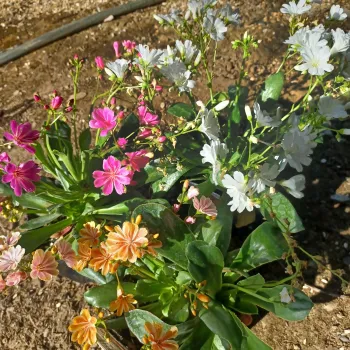Lewisia
Blog article by Jenni Dodini
My first encounter with Lewisia was at the Botanic Gardens in Reykjavik, Iceland. I was mesmerized, but alas, Fairfield doesn't have the same climate as Iceland. Honestly, though, at the time we were in Iceland in June, it was much the same as a nice day in San Francisco.

Imagine my surprise and delight when I discovered these plants while Toni and I were wandering about a local nursery. Of course, there was much discussion before I finally managed to choose these three plants. I even put on my glasses to read the tag! (Actually, I handed the tag to Toni since she had her glasses on.)
Anyway, I emerged victorious from the nursery and headed home.
Once home, I began to have misgivings about where I thought these little plants would thrive. Again, the hot day and vicious wind was nagging me into doing the right thing.....RESEARCH.
Here's what I found. Lewisia is of the family Montiaceae (Purslanes). Other names you might see are Siskiyou lewisia, Bitterroot, Cliff maids, and Heckner's lewisia.
There are MANY varieties, but the cotyledon is native to Southern Oregon and Northern California. We are a bit south of what was shown on the map, but it said the best success is in USDA zones 4-9. Of course, I then had to look up our zone, which is 9b.
Its natural habitat is in rocky alpine areas. It grows in cracks in the rocks, which makes it perfect for rock gardens. It likes fast-draining soil with a pH range of 5-7. The recommendation is to plant it in soil mixed with gravel to ensure proper drainage and to water only when the soil is dry, once the plant is established. Avoid over-watering. It only needs minimal to no fertilizer, only when blooming. (My kind of plant!) While the tag indicated "full sun", Calscape recommended part sun to direct morning sun, so my planting plan will change slightly. It will also grow well in containers.
It is a perennial plant that is dormant during the winter and returns to bloom from established roots from spring to early summer. Seeds can be saved for planting in the fall to early winter or offsets can be pruned and replanted from mature plants.
Of note, it attracts pollinators.
Lewis and Clark discovered it on their epic travels. The variety they encountered was Lewisia rediviva, the original Bitterroot, which was eaten by the native Americans for nutrition.
thumbnail photo: "Lewisia cotyledon 'Rainbow' - Léwisie de Siskiyou" by monteregina is licensed under CC BY-NC-SA 2.0.
